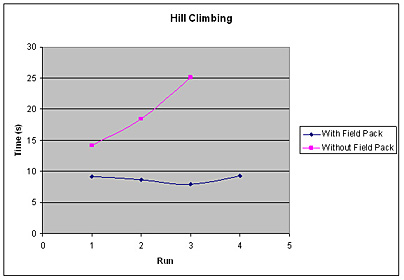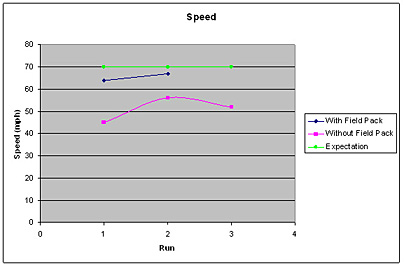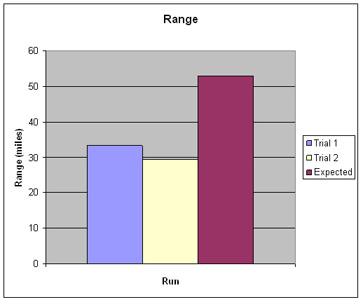
|
|
In the hill climbing test, we timed how fast the car climbed up a hill of known grade and length. The main pack voltage was kept a constant 72V in both trials. The grade was 6.8% and the length of the hill was 143ft, as shown by the calculations in the appendix. The main variable was the use of the field pack. In the 1st trial, the field pack was applied, enabling the car to climb the hill in an average time of 8.75 seconds. In the 2nd trial, the field pack was removed and the car was retested. The results showed a substantial decrease in performance, climbing the hill in an average of 19.23 seconds. On the final run of the 2nd trial, the car could not even make it up the hill. We believe that the only reason the car climbed the hill in the first three runs of the 2nd trial is because the field winding was still magnetized from the 1st trial. The results of this test gave us quantifiable data in which to compare future testing results with.
|

|
|
The results of the speed test are seen above. The car was taken to its top speed three separate times with and without the field pack. The results showed an overall increase in top speed when using the field battery pack. Without using the field pack, the average top speed was 51mph. When the field pack was applied, the average top speed increased to 65.5mph. In the last run using the field pack, the main contactor terminal melted off. This was attributed to a loose connection that caused a short. Without the field pack, the previous top speed was 45mph. It was increased to 56 by lengthening the accelerator pedal thus causing more displacement of the potentiometer. This drives the controller faster
|

|
|
The chart above shows the current range of the car and the range we expect to achieve upon completion of the project. The average max range is currently 31.35 miles. This is measured at full discharge of the batteries. When the project is completed, a range of 53 miles is predicted.
|





